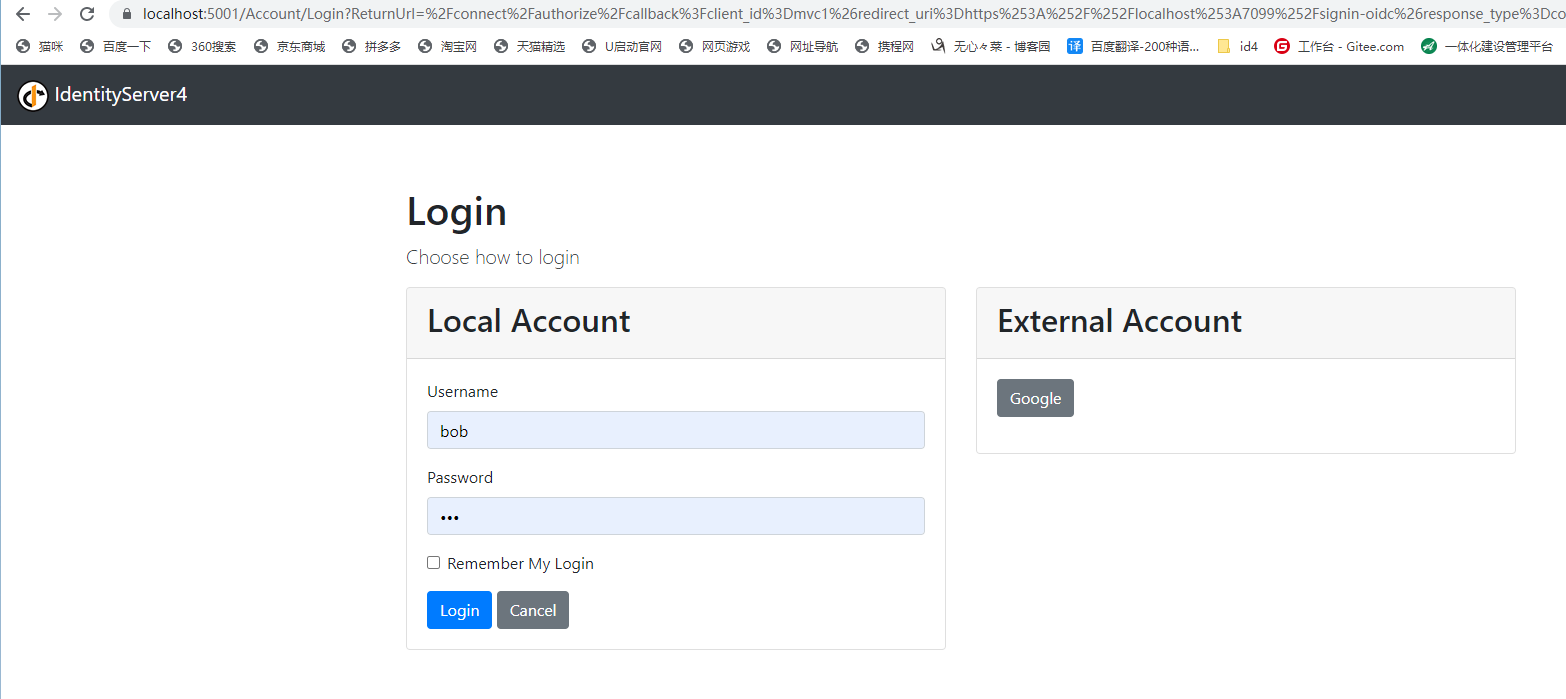NETCORE - IdentityServer4 单点登录SSO
NETCORE - IdentityServer4 单点登录SSO - oidc模式
测试项目
1. 服务端:NETCORE.ID4.SSO.Server(netcore3.1 MVC)
2. 客户端1:NETCORE.ID4.SSO.Client1(net6 webapi)
3. 客户端2:NETCORE.ID4.SSO.Client2(net6 webapi)
搭建服务端
下载模板,在 cmd 中运行:
dotnet new -i IdentityServer4.Templates dotnet new is4inmem
更名为:NETCORE.ID4.SSO.Server
在config.cs 文件中增加两个客户端配置
new Client { //客户端id ClientId = "mvc1", //客户端密钥 ClientSecrets = { new Secret("secret".Sha256()) }, //授权模式为code AllowedGrantTypes = GrantTypes.Code, //ids发放code时要回调客户端的地址 RedirectUris = { "https://localhost:7099/signin-oidc" }, //完成在ids中注销后回调客户端的这个地址 PostLogoutRedirectUris = { "https://localhost:7099/signout-callback-oidc" }, //ids允许此客户端访问这些scope AllowedScopes = new List<string> { IdentityServerConstants.StandardScopes.OpenId, IdentityServerConstants.StandardScopes.Profile } }, new Client { //客户端id ClientId = "mvc2", //客户端密钥 ClientSecrets = { new Secret("secret".Sha256()) }, //授权模式为code AllowedGrantTypes = GrantTypes.Code, //ids发放code时要回调客户端的地址 RedirectUris = { "https://localhost:7271/signin-oidc" }, //完成在ids中注销后回调客户端的这个地址 PostLogoutRedirectUris = { "https://localhost:7271/signout-callback-oidc" }, //ids允许此客户端访问这些scope AllowedScopes = new List<string> { IdentityServerConstants.StandardScopes.OpenId, IdentityServerConstants.StandardScopes.Profile } }
创建客户端1
NETCORE.ID4.SSO.Client1(net6 webapi)
安装 nuget 包:Microsoft.AspNetCore.Authentication.OpenIdConnect

配置:Program.cs
using System.IdentityModel.Tokens.Jwt; var builder = WebApplication.CreateBuilder(args); var config = builder.Configuration; builder.Services.AddControllers(); // Learn more about configuring Swagger/OpenAPI at https://aka.ms/aspnetcore/swashbuckle builder.Services.AddEndpointsApiExplorer(); builder.Services.AddSwaggerGen(); builder.Services.AddControllersWithViews(); JwtSecurityTokenHandler.DefaultMapInboundClaims = false;//还没研究过它是干啥的 builder.Services.AddAuthentication(options => //注册asp.net core 身份验证核心服务,并配置 { options.DefaultScheme = "Cookies";//默认的身份验证方案名 options.DefaultChallengeScheme = "oidc";//用来跳转到dis登录页的身份验证方案名 //注意这俩配置与下面注册的身份验证方案的名字对应 }) .AddCookie("Cookies")//注册asp.net core 默认的基于cookie的身份验证方案 .AddOpenIdConnect("oidc", options =>//注册ids为我们提供的oidc身份验证方案 { options.Authority = "https://localhost:5001";//配置ids的根路径 options.ClientId = "mvc1";//此客户但的id options.ClientSecret = "secret";//此客户端的密钥 options.ResponseType = "code";//授权模式 options.SaveTokens = true;//是否将最后获取的idToken和accessToken存储到默认身份验证方案中 }); var app = builder.Build(); // Configure the HTTP request pipeline. if (app.Environment.IsDevelopment()) { app.UseSwagger(); app.UseSwaggerUI(); } app.UseHttpsRedirection(); app.UseAuthentication(); app.UseAuthorization(); app.MapControllers(); app.Run();
增加 WebApi 控制器:ValuesController.cs
using Microsoft.AspNetCore.Authorization; using Microsoft.AspNetCore.Http; using Microsoft.AspNetCore.Mvc; namespace NETCORE.ID4.SSO.Client1.Controllers { [Route("api/[controller]")] [ApiController] public class ValuesController : ControllerBase { [HttpGet] [Route("get1")] public string get1() { return "value1"; } [HttpGet] [Route("get2")] [Authorize] public string get2() { return "value2"; } } }
创建客户端2
NETCORE.ID4.SSO.Client2(net6 webapi)
安装 nuget 包:Microsoft.AspNetCore.Authentication.OpenIdConnect
增加 WebApi 控制器(与client1一样):ValuesController.cs
配置:Program.cs
using System.IdentityModel.Tokens.Jwt; var builder = WebApplication.CreateBuilder(args); // Add services to the container. var config = builder.Configuration; builder.Services.AddControllers(); // Learn more about configuring Swagger/OpenAPI at https://aka.ms/aspnetcore/swashbuckle builder.Services.AddEndpointsApiExplorer(); builder.Services.AddSwaggerGen(); #region IdentityServer4 builder.Services.AddControllersWithViews(); JwtSecurityTokenHandler.DefaultMapInboundClaims = false;//还没研究过它是干啥的 builder.Services.AddAuthentication(options => //注册asp.net core 身份验证核心服务,并配置 { options.DefaultScheme = "Cookies";//默认的身份验证方案名 options.DefaultChallengeScheme = "oidc";//用来跳转到dis登录页的身份验证方案名 //注意这俩配置与下面注册的身份验证方案的名字对应 }) .AddCookie("Cookies")//注册asp.net core 默认的基于cookie的身份验证方案 .AddOpenIdConnect("oidc", options =>//注册ids为我们提供的oidc身份验证方案 { options.Authority = "https://localhost:5001";//配置ids的根路径 options.ClientId = "mvc2";//此客户但的id options.ClientSecret = "secret";//此客户端的密钥 options.ResponseType = "code";//授权模式 options.SaveTokens = true;//是否将最后获取的idToken和accessToken存储到默认身份验证方案中 }); #endregion var app = builder.Build(); // Configure the HTTP request pipeline. if (app.Environment.IsDevelopment()) { app.UseSwagger(); app.UseSwaggerUI(); } app.UseHttpsRedirection(); app.UseAuthentication(); app.UseAuthorization(); app.MapControllers(); app.Run();
测试:
在同一浏览器中
直接访问:https://localhost:7099 的接口

访问 https://localhost:7099/api/values/get2时,会跳转到登录页

登录后,会自动跳转获取数据

在访问client2 的接口时,会自动跳转一下鉴权服务,发现已登录,会自动跳转回来,获取到数据

参考 :https://www.bbsmax.com/A/QW5Y71mKzm/




 浙公网安备 33010602011771号
浙公网安备 33010602011771号